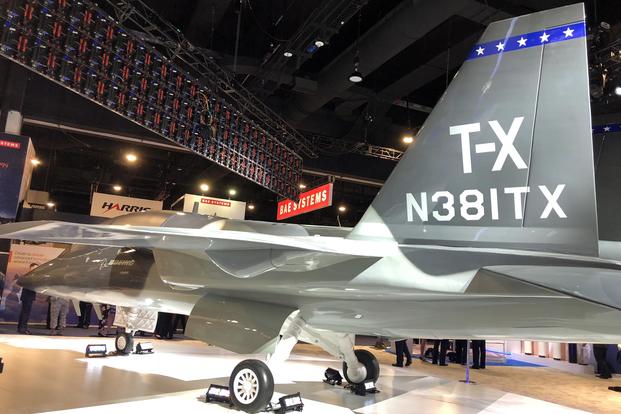The U.S. Air Force has awarded Boeing a $9.2 billion contract to build the service's next aircraft for training future pilots.
The firm fixed-price contract award includes funding for 351 jets, 46 simulators and associated ground equipment, Boeing said. The payment structure, officials said, also allows for an indefinite-delivery indefinite-quantity option to give the Air Force the opportunity to purchase up to 475 aircraft and 120 simulators.
"This new aircraft will provide the advanced training capabilities we need to increase the lethality and effectiveness of future Air Force pilots," Air Force Secretary Heather Wilson said in a release. "Through competition we will save at least $10 billion on the T-X program."
Reuters was first to report the news.
Related content:
- Air Force Delays Contract for T-X Replacement Until Spring
- Is the Air Force's T-X Program in Limbo?
- T-X Trainer Is Coming But What About Light Attack?
Air Force officials said Thursday they are confident Boeing will deliver what the service requires, even at a lower price ceiling than originally discussed.
"We used and scored and conducted the source selection on all of the documents, and everything in the request for proposal that we communicated to industry, and that [resulted in] the awardee," said Lt. Gen. Arnold Bunch, the Air Force's military deputy for the Office of the Assistant Secretary for Acquisition at the Pentagon.
Bunch, alongside Assistant Secretary of the Air Force for Acquisition, Technology and Logistics Will Roper, briefed reporters at the Pentagon Thursday following the award announcement.
The Air Force wants to buy the new jets to replace its current Northrop Grumman-made T-38 Talon trainers, at a time when the service is struggling to replenish its fighter pilot ranks. The first T-X aircraft and simulators are scheduled to arrive at Joint Base San Antonio-Randolph in 2023. All Education and Training Command bases that currently have a T-38 program will transition to the Boeing model.
"We have a very deliberate process to evaluate risk, cost and technical factors in the program. It's rigorous," Roper added. "Overall, our assessment was [that] Boeing had the proposal that was best value."
The announcement marks the third major contract in recent weeks for Boeing, the U.S.' largest aerospace firm. The Air Force this week also selected the company to build the replacement for its UH-1N Huey helicopter, at a cost of approximately $2.38 billion. And last month, the Navy selected the firm to build its first operational carrier-based MQ-25 tanker drone.
"Today's announcement is the culmination of years of unwavering focus by the Boeing and Saab team," said Leanne Caret, president and CEO of Boeing Defense, Space & Security, in a release. "It is a direct result of our joint investment in developing a system centered on the unique requirements of the U.S. Air Force. We expect T-X to be a franchise program for much of this century."
Bunch said there were certain aircraft attributes the Air Force valued and looked for in a proposal: higher angle-of-attack, and the ability to withstand greater levels of G-force, among others.
These factors "would help us later on with how we train the pilots," Bunch said Thursday.
In the T-38, he added, training is limited because "of the legacy system."
"We want to turn out an aviator that's better prepared to go into their follow-on fight," Bunch said.
Boeing unveiled its sleek T-X trainer jet during a ceremony at its St. Louis facility in 2016. The Chicago-based company, collaborating with Saab, competed with a new, clean-sheet design against Lockheed Martin and Korea Aerospace Industries, which proposed a variant of KAI's T-50; and Leonardo DRS' T-100 modified jet design. Northrop had been in the running early on -- also with a brand-new design -- but withdrew from the competition in early 2017.
Boeing's jet offers a twin-canted, vertical tail design, mimicking fourth- and fifth-generation fighter jets such as the F-22 Raptor, F-35 Joint Strike Fighter and F/A-18 Hornet.
While the original service cost estimate for the T-X replacement program was $19.7 billion, the Air Force in 2016 announced a $16 billion competition to build the aircraft. Firms that were publicly competing for the contract included Boeing, Lockheed and Leonardo, but it was said Sierra Nevada Corp. and Turkish Aerospace Industries were also partnering on their own design.
The contract award had been anticipated by the end of 2017, but officials cited ongoing program reviews and discussions with defense industry executives as reasons for delaying the contract announcement.
"It is the review, the review of the proposals, and ensuring that we have the right items taken care of," Bunch told reporters last year.
"This is a case ... sometimes you need to go slow in order to go fast," he said of the acquisition strategy. "Because if we do it [too fast], we end up in a protest, and [if ] we go through that process, it will set us back. It will take us even longer."
The new trainer cannot come too soon for the service as it grapples with using its aging T-38 Talons, as well as its T-6 Texan II aircraft.
The Air Force most recently cleared its fleet of T-6 trainers to resume training operations at Joint Base San Antonio-Randolph after a "brief pause" following a crash near the base Sept. 18. Both pilots safely ejected from the aircraft. The Texan was also grounded in February after ongoing reports of pilots suffering breathing problems.
That crash followed another trainer mishap in Texas on Sept. 11. In that incident, a T-38C from Sheppard Air Force Base, Texas, crashed after takeoff, officials said.
Two other T-38s have crashed this calendar year. Last November, total hydraulic failure in a T-38 from Laughlin Air Force Base, Texas, caused that aircraft to crash. The accident killed Capt. Paul J. Barbour, 32, who was on a requalification flight that day.
-- Oriana Pawlyk can be reached at oriana.pawlyk@military.com. Follow her on Twitter at @Oriana0214.













